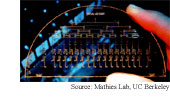|
NEWS
|
Camouflaged
messages
An optical
version of the spread spectrum technology used for
cell phone transmissions promises secure messaging over
standard fiber-optic telecommunications networks. The
technology, originally used for secure military radio
communications, makes messages sound like background noise
to eavesdroppers. (A Method for Secure Communications
over a Public Fiber-Optical Network, Optics Express,
May 1, 2006)
Pneumatic logic
 Logic gates formed by a set of tiny
pneumatic valves control the flow of liquids on a
biochip, allowing for complex control of samples and chemicals
used in medical testing and biological research. The system
enables a small number of pneumatic inputs to control
a large number of valves -- for example ten inputs for
up to 512 valves. (Development and Multiplexed Control
of Latching Pneumatic Valves Using Microfluidic Logical
Structures, Lab on a Chip, May 2006)
Logic gates formed by a set of tiny
pneumatic valves control the flow of liquids on a
biochip, allowing for complex control of samples and chemicals
used in medical testing and biological research. The system
enables a small number of pneumatic inputs to control
a large number of valves -- for example ten inputs for
up to 512 valves. (Development and Multiplexed Control
of Latching Pneumatic Valves Using Microfluidic Logical
Structures, Lab on a Chip, May 2006)
Cell phone traffic tracks weather
Rainfall impairs radio signals, and the degree
of impairment turns out to be an accurate
measure of rainfall. This discovery opens the possibility
of using existing cell phone networks as worldwide weather
stations. (Environmental Monitoring by Wireless Communication
Networks, Science, May 5, 2006)
Flexible circuits get speedy
A method of applying
traditional computer chip materials to flexible plastic
surfaces produces transistors that operate in the gigahertz
range, which is the speed of today's computer and communications
devices. The technique could be used to produce high-performance
electronic paper and flexible displays. (Gigahertz operation
in flexible transistors on plastic substrates, Applied
Physics Letters, May 1, 2006)
Metal-like plastic
A plastic
that conducts like a metal could significantly improve
the performance of conducting polymers. The specially
prepared form of polyailine could lead to flexible and/or
disposable plastic electronic devices. (Metallic transport
in polyaniline, Nature, May 4, 2006)
Molecular electronics get stable
The idea of making electronic devices from single
layers of molecules has been around for years, but prototypes
tend to be fragile and inconsistent. A method of making
self-assembled monolayers yields stable electronics,
advancing efforts to use molecular layers to make small,
flexible and/or high-speed computer circuits. (Towards
molecular electronics with large-area molecular junctions,
Nature, May 4, 2006) |
FEATURES
|
View
from the High Ground: Cornell's Jon Kleinberg
Six degrees of separation, buying gasoline
by the molecule, the science of popularity, all just getting
along online, intellectual prosthetics, Big Science, making
up questions, and telling stories.
|
How
It Works: Quantum computing: qubits
Photons, electrons and atoms, oh my! These particles are
the raw materials for qubits, the basic building blocks
of quantum computers. |
|
 |
News RSS feed 
Blog RSS feed 
Bookshelf RSS feed

New: TRN's
Internet Services
TRN's Jobs Center
|
| |
|
| |
|
| |
"In
most areas of science and technology, the origins
of new breakthroughs can still be found in the work
of a small number of people -- or even a single
person -- working at their own pace on their own
questions, pursuing things that interest them. "
- Jon Kleinberg, Cornell University |
|
| |
|
| |
Thanks
to Kevin from
GoldBamboo.com
for technical support |
|

